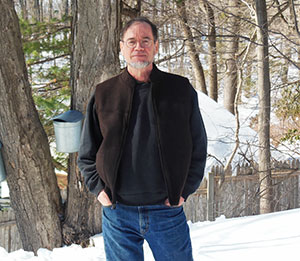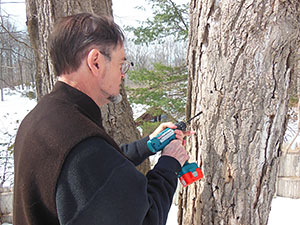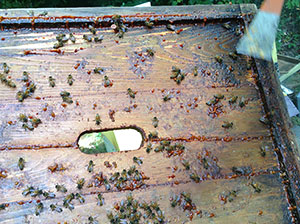

Living Off the Land
Steve Walkley: Living the Sweet Life

Dr. Steve Walkley on his property, tapping maple treesAt Einstein, you can find Dr. Steven Walkley, director of Einstein’s Rose F. Kennedy Intellectual and Developmental Disabilities Research Center and professor in the Dominick P. Purpura Department of Neuroscience, in his office or laboratory in the Kennedy Center. It is there that he conducts research on neurogenetic diseases that cause intellectual disability. His most recent work has led to discovery of a promising treatment for Niemann-Pick type C—a degenerative brain disease affecting young children—that is currently in phase 2-3 clinical trials. At home, you’ll more likely find him outside, pursuing hobbies that offer a different kind of promising results.
In 1987, when Dr. Walkley and his wife Rebecca found the house that would become their home in northern Westchester County, they encountered the current owner cooking down the sap he had collected from maple trees on the property. This introduction to the joys of backyard sugaring became an annual pre-spring ritual for the Walkleys and one their son and daughter looked forward to whenever winter neared its end.
Originally from Alabama and Louisiana, respectively, the couple liked the idea of living off the land. Both had grown up with small backyard gardens, as was common in the South, so Rebecca Walkley knew she’d be able to get good crops from their property’s soil. But the notion of making their own maple syrup was new to both of them.
“In the South along the Gulf coast, freezing weather is rare,” said Dr. Walkley, who also is professor of pathology and in the Saul R. Korey Department of Neurology. “You know it’s time to tap when you have your first thaw. Temperatures go above freezing during the day and then back down at night. That’s when the sap begins to run.”
This past year, the thaw was the latest either of them could recall. “It was March before we could put taps into the trees, and we had to shovel a path to get to them,” he recalled. “Usually, we can start tapping in February, sometimes even January. The longer the period of thawing temperatures by day and freezing temperatures at night, the longer you have sap running.”
A Love of Labor
Even with the late start this year, the couple was able to make a decent batch of syrup and held their annual cook-down party with members of the Walkley lab. They tapped 9 of the 15 maples trees on their property and stored the sap in bins set on the north side of their home. “It’s the shadiest, coldest part of the property, so the sap stays cold,” explained Dr. Walkley. “It separates from the ice that forms at the top, and we skim that off to pour the sap into the restaurant-sized lasagna pan we use to boil it.”

Preparing the tree for the tapAfter creating a makeshift cooking area using cinderblocks, bricks, two-by-fours and sheet metal, Dr. Walkley sets the lasagna pan in place and hooks up a propane tank to provide heat. The sap boils all weekend or even longer, with new sap added as it cooks down. Occasional stirring keeps the sap from burning or boiling over. A significant part of the process involves the evaporation of the water in the sap, which escapes as steam—a big reason the boiling process takes place outdoors.
The resulting syrup is transferred to a large pot, where it’s cooked down further and poured through a cloth filter, and then funneled into bottles.
Just like with laboratory research, the maple sugaring process is time-consuming and labor-intensive. You can get about two gallons of syrup from 75 gallons of sap—and that’s in a good year.
“There’s nothing like fresh maple syrup on your pancakes, and it tastes even better when you’ve done all the legwork, from tapping the trees, to storing the gallons of sap and cooking it down until it’s that beautiful amber syrup,” said Dr. Walkley.
Sweetening the Pot
The golden syrup is a sweet treat that the Walkley family has enjoyed making every year for nearly 30 years. About 12 years ago, Rebecca Walkley wondered, “why have just syrup when you also can have honey?”
“Rebecca decided to get honeybees and ordered a package of them, and I bought her a hive,” explained Dr. Walkley. “We have our garden, which provides organic fruit and vegetables. Honeybees could pollinate our crops and provide honey as well. But mostly, we thought it’d be neat to have a hive.”
The early hives were not productive. The first bees didn’t manufacture enough honey beyond what they would need to survive the winter, so there wasn’t anything the Walkleys could harvest for their own use. Eventually they gave up on beekeeping—until last year.
“We set it up and I tended it,” said Dr. Walkley. “That autumn, we got our first honey.”
Un-Bee-Lievable Productivity

Busy beesThis year, concerned that the bees wouldn’t survive the harsh winter, Dr. Walkley ordered a new package of bees. Before they arrived, the same weekend he did his first tapping of the maples he noticed bees going in and out of the existing hive. “It was exciting to see that they had survived. They were landing on the snow and buzzing around the hive.”
When the new honeybees arrived, he set up a second hive. As autumn approached, he went to check on honey production for each. Removing the lid from the top tower forming the hive, he first checked on the jar of sugar water he had recently placed there as a food supplement for the bees. In the older hive, the water was nearly untouched, and a look at the frames within the lower hive bodies showed very little honey production.
Expecting the same in the newer hive, he was surprised to find the jar was empty with about a dozen bees clinging to the lid, hoping for a last sip. The frames in the two main hive bodies were so laden with honey they were difficult to lift. So he helped himself to several of the frames and left the rest in place for the bees’ food.
Later, in his kitchen, he used a hand-crank centrifuge to separate the honey from the frames. As the deep rich honey rolled out of the centrifuge, he marveled, “How sweet it is!”
Photo Gallery
(To view slideshow of photo gallery, click on an image below; then move your mouse over the left or right margins to navigate.)
Posted on: Monday, December 14, 2015














Tablet Blog